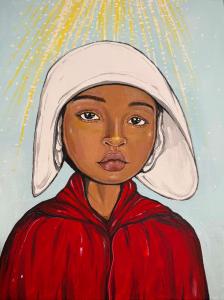Artist Ivory Estella Balliol Honors and Advocates for Adriana Smith—Woman on Life Support—with New Artwork
Powerful new artwork titled "Too Much Labor" by fine artist Ivory Estella Balliol will be gifted to the family of Adriana Smith, who is still on life support.
The 24-year-old artist, known for her multidisciplinary approach and outspoken advocacy for women’s rights and reproductive freedom, announced that "Too Much Labor" will be gifted to Adriana Smith’s family on Juneteenth—a day symbolizing liberation and emancipation from oppression. “Women are still slaves to patriarchal states that think they own women's bodies,” Ivory Estella Balliol states. “This must end now!”
About Ivory Estella Balliol
A polymathic force—phlebotomist, dancer, visual artist, and free-spirited science lover—Ivory Estella Balliol brings fierce intellect, personal history, and feminist urgency to her work. With roots in Argentine, Irish, and Scandinavian heritage and a background shaped by conservative religion, she’s long challenged dogma and outdated norms, especially those that try to control a woman’s sense of self, sex, and body. Evolving on her own to question everything and live with curiosity, Ivory Estella Balliol has become a bold voice for autonomy and freedom. She is especially moved by young girls and women who are denied agency over their lives and bodies.
About the New Artwork: Too Much Labor
The painting, "Too Much Labor," takes its name and mood from the viral feminist anthem "Labor" by Paris Paloma, a song that’s become emblematic of modern resistance to institutional misogyny. Frequently used in TikTok videos comparing modern struggles with those depicted in "The Handmaid’s Tale," the song is an apt soundtrack for a moment when real-life policies echo dystopian fiction. Visually, the artwork is a fusion of grief and protest. Haunting and vibrant, it captures the disturbing paradox of a young woman forced to remain biologically alive while already gone, tethered by legal and religious forces to a body that can no longer feel, speak, or choose.
Through oil paint, blood-red hues, and symbolic layering, Ivory Estella Balliol weave’s themes of sacrifice, state control, and girlhood interrupted. Viewers are confronted with the uncomfortable reality: that Adriana’s body has become a battleground, not just for her family’s grief, but for ideological control. Ivory Estella Balliol states of the painting, “I gave her streams of heavenly light coming down on her and some shimmer on her eyes and in her skin because she’s an angel now, and a mother who was full of life and deserved better.” Ivory adds, “The bonnet and cloak; a symbol of oppression, remains dull and boring. These are symbolic homages to “The Handmaid's Tale,” as well as information conveyed by her family. This all suggests conversations on the issues at hand, with the goal to raise consciousness.”
Painting to Be Delivered on Juneteenth (June 19, 2025)
In a gesture both tender and politically charged, Ivory Estella Balliol will personally send the painting to the Smith family on Juneteenth, a date symbolizing the end of chattel slavery in the United States. The artist sees a chilling parallel in the ways women are still enslaved by laws that strip away bodily freedom. “This is not liberation,” she says. “This is cruelty dressed up in morality. What does that say about us?”
As reported by NPR and other major news outlets, Adriana Smith’s case has ignited legal and ethical debates. The controversial so-called LIFE Act, which defines life as beginning at conception, has sparked confusion over how brain death is interpreted under the law. Though declared brain-dead by medical professionals, she remains on life support due to the new law’s implications. The family, trapped in grief and legislative restriction, has had to fight for the right to say goodbye with dignity.
Love, Solidarity, and Outrage
For Ivory Estella Balliol, this painting is about more than grief—it’s about witnessing. About not turning away when the political system harms women. “I cannot take their pain away,” Ivory Estella Balliol says, “but I can let them know they are not alone. That someone sees their daughter—not as a symbol or a legal dilemma—but as a woman who deserved freedom, not forced labor, even in death.” The painting will be accompanied by a letter from the artist, a handwritten message of compassion, addressed directly to Adriana’s mother.
Art as Protest, Art as Offering
Ivory Estella Balliol’s act of resistance comes as women across the U.S. confront an increasingly restrictive post-Roe legal landscape. With Georgia at the center of national debates on reproductive rights and end-of-life care, the artist states, "This artwork, "Too Much Labor" isn’t just about Adriana Smith, it’s about every woman and girl caught in systems that treat their bodies as property. A civilized society needs to change that.”
About the Artist
Ivory Estella Balliol is a dynamic fine artist known for her powerful work that blends sensuality, rebellion, and unfiltered self-expression. Raised in a conservative environment, Ivory broke from tradition early on, forging a life rooted in curiosity, bold aesthetics, and unapologetic individuality. Inspired by science and underground subcultures, her aesthetic is ever-evolving, deeply personal, and viscerally felt. Making her very life an act of art and protest, Ivory is also an unforgettable presence on the North American festival circuit as a dancer, cosplayer, and muse. Each of her creations serves as both a declaration and a mirror—confronting convention, inviting connection, and sparking emotional truth. Ivory doesn't just make art; she lives it. Her work dares audiences to see differently, feel more deeply, and step bravely into their own power.
@skullsparklez
https://www.instagram.com/skullsparklez/
Bruce Edwin
Hollywood Sentinel PR
+1 310-226-7176
email us here
Visit us on social media:
LinkedIn
Instagram
Facebook
X
Other
Legal Disclaimer:
EIN Presswire provides this news content "as is" without warranty of any kind. We do not accept any responsibility or liability for the accuracy, content, images, videos, licenses, completeness, legality, or reliability of the information contained in this article. If you have any complaints or copyright issues related to this article, kindly contact the author above.
leagend RT200: A Professional Lithium Battery Tester Designed for Accurate, Reliable Diagnostics
ACP Painting, LLC Featured on Rosie On The House Podcast: A Deep Dive Into Arizona House Painting
Premium 73‑Acre Off‑Grid Luxury Barndominium Estate Listed Near Richards, Texas
Kalendarium
Więcej ważnych informacji
 Jedynka Newserii
Jedynka Newserii

 Jedynka Newserii
Jedynka Newserii

Prawo

Trwają dyskusje nad kształtem unijnego budżetu na lata 2028–2034. Mogą być rozbieżności w kwestii Funduszu Spójności czy dopłat dla rolników
Trwają prace nad wieloletnimi unijnymi ramami finansowymi (WRF), które określą priorytety wydatków UE na lata 2028–2034. W maju Parlament Europejski przegłosował rezolucję w sprawie swojego stanowiska w tej sprawie. Postulaty europarlamentarzystów mają zostać uwzględnione we wniosku Komisji Europejskiej w sprawie WRF, który zostanie opublikowany w lipcu 2025 roku. Wciąż jednak nie ma zgody miedzy państwami członkowskimi, m.in. w zakresie Funduszu Spójności czy budżetu na rolnictwo.
Konsument
35 proc. gospodarstw domowych nie stać na zakup mieszkania nawet na kredyt. Pomóc może wsparcie budownictwa społecznego i uwolnienie gruntów pod zabudowę

W Polsce co roku oddaje się do użytku ok. 200 tys. mieszkań, co oznacza, że w ciągu dekady teoretycznie potrzeby mieszkaniowe społeczeństwa mogłyby zostać zaspokojone. Jednak większość lokali budują deweloperzy na sprzedaż, a 35 proc. gospodarstw domowych nie stać na zakup nawet za pomocą kredytu. Jednocześnie ta grupa zarabia za dużo, by korzystać z mieszkania socjalnego i komunalnego. Zdaniem prof. Bartłomieja Marony z UEK zmniejszeniu skali problemu zaradzić może wyłącznie większa skala budownictwa społecznego zamiast wspierania kolejnymi programami zaciągania kredytów.
Problemy społeczne
Hejt w sieci dotyka coraz więcej dzieci w wieku szkolnym. Rzadko mówią o tym dorosłym

Coraz większa grupa dzieci zaczyna korzystać z internetu już w wieku siedmiu–ośmiu lat – wynika z raportu NASK „Nastolatki 3.0”. Wtedy też stykają się po raz pierwszy z hejtem, którego jest coraz więcej w mediach społecznościowych. Według raportu NASK ponad 2/3 młodych internautów uważa, że mowa nienawiści jest największym problemem w sieci. Co więcej, dzieci rzadko mówią o takich incydentach dorosłym, dlatego tym istotniejsze są narzędzia technologiczne służące ochronie najmłodszych.
Partner serwisu
Szkolenia

Akademia Newserii
Akademia Newserii to projekt, w ramach którego najlepsi polscy dziennikarze biznesowi, giełdowi oraz lifestylowi, a także szkoleniowcy z wieloletnim doświadczeniem dzielą się swoją wiedzą nt. pracy z mediami.









.gif)

 |
| |
| |
|